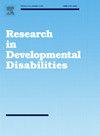Longitudinal perspective on nonverbal intelligence development in young children with developmental language disorder
IF 2.9
2区 医学
Q1 EDUCATION, SPECIAL
引用次数: 0
Abstract
Background
Nonverbal intelligence has been linked to language impairments and adaptational outcomes in clinical populations. However, the development of nonverbal intelligence in conjunction with language difficulties is still poorly understood.
Aims
This study aims to characterize the progression of nonverbal intelligence in young children with Developmental Language Disorder (DLD).
Methods and Procedures
This study collected data from medical records of children seen in a child psychiatric clinic. The sample consisted of 71 children diagnosed with DLD who had completed two Wechsler scale assessments. The first assessment took place at the mean age of 4:11 years, and the second at the mean age of 8:2 years.
Outcomes and Results
Three groups were formed according to the evolution of nonverbal intelligence: decrease (n = 22), increase (n = 21), and stability (n = 28). Multivariate analyses of covariance indicated that initial verbal and nonverbal intellectual skills, multilingualism, and age distinguished these three groups and effects were medium to large. Children in the increasing path are significantly younger and have significantly lower initial verbal and nonverbal intellectual skills.
Conclusions and Implications
Evolution of nonverbal development in children with DLD seems highly variable. More studies are needed, but very young children with DLD may not be able to demonstrate their full intellectual potential in standardized Weschler assessments. It would be advisable to continue to follow the evolution of their abilities with caution to personalize interventions.
What this paper adds
Developmental Language Disorder (DLD) is a diagnosis directly related to expressive and receptive language difficulties. Therefore, assessment and intervention are focused on verbal and language ability. Children with DLD also seem to have nonverbal cognitive weaknesses, but the understanding of nonverbal development in this population is limited. Among school-aged children, a great deal of variation in nonverbal abilities according to age is observed, possibly linked to the type of assessment used. Nonverbal intelligence has been related to functional outcomes in children, adolescents, and adults with DLD, thus warranting further investigation. This paper explores different nonverbal intelligence developmental evolutions of children from diverse ethnic groups, ensuring representation from large urban areas, and the clinical factors related to those trajectories. Three developmental profiles were differentiated: increase (29.6 %), stability (39.4 %), and decrease (31 %), which were distinguished by initial verbal and nonverbal intelligence as well as age. Having weaker verbal and nonverbal intelligence and being younger were associated with increasing nonverbal intelligence between the two time points. Development of nonverbal intelligence seems highly variable among preschoolers diagnosed with DLD who consulted in a clinical setting, with children being just as likely to improve, maintain, or decrease in ability. These findings may also indicate that nonverbal intelligence assessments may not capture the true nonverbal potential of younger children with DLD, especially when they show an array of difficulties. More research is needed to understand the different trajectories of nonverbal development, but current results encourage caution in the intellectual assessments of children with DLD.
求助全文
约1分钟内获得全文
求助全文
来源期刊

Research in Developmental Disabilities
Multiple-
CiteScore
5.50
自引率
6.50%
发文量
178
期刊介绍:
Research In Developmental Disabilities is aimed at publishing original research of an interdisciplinary nature that has a direct bearing on the remediation of problems associated with developmental disabilities. Manuscripts will be solicited throughout the world. Articles will be primarily empirical studies, although an occasional position paper or review will be accepted. The aim of the journal will be to publish articles on all aspects of research with the developmentally disabled, with any methodologically sound approach being acceptable.
 求助内容:
求助内容: 应助结果提醒方式:
应助结果提醒方式:


